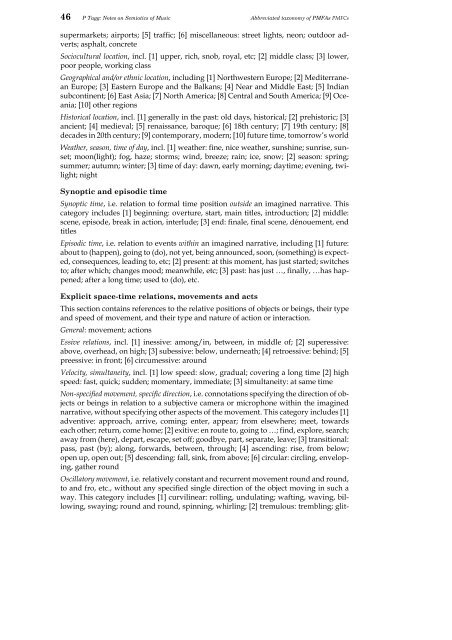Introductory notes to the Semiotics of Music - Philip Tagg's home page
Introductory notes to the Semiotics of Music - Philip Tagg's home page
Introductory notes to the Semiotics of Music - Philip Tagg's home page
You also want an ePaper? Increase the reach of your titles
YUMPU automatically turns print PDFs into web optimized ePapers that Google loves.
46 P Tagg: Notes on <strong>Semiotics</strong> <strong>of</strong> <strong>Music</strong> Abbreviated taxonomy <strong>of</strong> PMFAs PMFCs<br />
supermarkets; airports; [5] traffic; [6] miscellaneous: street lights, neon; outdoor adverts;<br />
asphalt, concrete<br />
Sociocultural location, incl. [1] upper, rich, snob, royal, etc; [2] middle class; [3] lower,<br />
poor people, working class<br />
Geographical and/or ethnic location, including [1] Northwestern Europe; [2] Mediterranean<br />
Europe; [3] Eastern Europe and <strong>the</strong> Balkans; [4] Near and Middle East; [5] Indian<br />
subcontinent; [6] East Asia; [7] North America; [8] Central and South America; [9] Oceania;<br />
[10] o<strong>the</strong>r regions<br />
His<strong>to</strong>rical location, incl. [1] generally in <strong>the</strong> past: old days, his<strong>to</strong>rical; [2] prehis<strong>to</strong>ric; [3]<br />
ancient; [4] medieval; [5] renaissance, baroque; [6] 18th century; [7] 19th century; [8]<br />
decades in 20th century; [9] contemporary, modern; [10] future time, <strong>to</strong>morrow’s world<br />
Wea<strong>the</strong>r, season, time <strong>of</strong> day, incl. [1] wea<strong>the</strong>r: fine, nice wea<strong>the</strong>r, sunshine; sunrise, sunset;<br />
moon(light); fog, haze; s<strong>to</strong>rms; wind, breeze; rain; ice, snow; [2] season: spring;<br />
summer; autumn; winter; [3] time <strong>of</strong> day: dawn, early morning; daytime; evening, twilight;<br />
night<br />
Synoptic and episodic time<br />
Synoptic time, i.e. relation <strong>to</strong> formal time position outside an imagined narrative. This<br />
category includes [1] beginning: overture, start, main titles, introduction; [2] middle:<br />
scene, episode, break in action, interlude; [3] end: finale, final scene, dénouement, end<br />
titles<br />
Episodic time, i.e. relation <strong>to</strong> events within an imagined narrative, including [1] future:<br />
about <strong>to</strong> (happen), going <strong>to</strong> (do), not yet, being announced, soon, (something) is expected,<br />
consequences, leading <strong>to</strong>, etc; [2] present: at this moment, has just started; switches<br />
<strong>to</strong>; after which; changes mood; meanwhile, etc; [3] past: has just …, finally, …has happened;<br />
after a long time; used <strong>to</strong> (do), etc.<br />
Explicit space-time relations, movements and acts<br />
This section contains references <strong>to</strong> <strong>the</strong> relative positions <strong>of</strong> objects or beings, <strong>the</strong>ir type<br />
and speed <strong>of</strong> movement, and <strong>the</strong>ir type and nature <strong>of</strong> action or interaction.<br />
General: movement; actions<br />
Essive relations, incl. [1] inessive: among/in, between, in middle <strong>of</strong>; [2] superessive:<br />
above, overhead, on high; [3] subessive: below, underneath; [4] retroessive: behind; [5]<br />
preessive: in front; [6] circumessive: around<br />
Velocity, simultaneity, incl. [1] low speed: slow, gradual; covering a long time [2] high<br />
speed: fast, quick; sudden; momentary, immediate; [3] simultaneity: at same time<br />
Non-specified movement, specific direction, i.e. connotations specifying <strong>the</strong> direction <strong>of</strong> objects<br />
or beings in relation <strong>to</strong> a subjective camera or microphone within <strong>the</strong> imagined<br />
narrative, without specifying o<strong>the</strong>r aspects <strong>of</strong> <strong>the</strong> movement. This category includes [1]<br />
adventive: approach, arrive, coming; enter, appear; from elsewhere; meet, <strong>to</strong>wards<br />
each o<strong>the</strong>r; return, come <strong>home</strong>; [2] exitive: en route <strong>to</strong>, going <strong>to</strong> …; find, explore, search;<br />
away from (here), depart, escape, set <strong>of</strong>f; goodbye, part, separate, leave; [3] transitional:<br />
pass, past (by); along, forwards, between, through; [4] ascending: rise, from below;<br />
open up, open out; [5] descending: fall, sink, from above; [6] circular: circling, enveloping,<br />
ga<strong>the</strong>r round<br />
Oscilla<strong>to</strong>ry movement, i.e. relatively constant and recurrent movement round and round,<br />
<strong>to</strong> and fro, etc., without any specified single direction <strong>of</strong> <strong>the</strong> object moving in such a<br />
way. This category includes [1] curvilinear: rolling, undulating; wafting, waving, billowing,<br />
swaying; round and round, spinning, whirling; [2] tremulous: trembling; glit-














